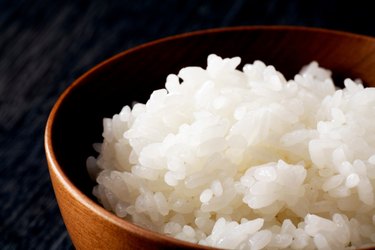
For such a universal staple, rice can be a frustrating challenge to master. Misjudge the cooking time or water level and the rice can emerge burnt and unusable or mushy and unpalatable. Knowing your rice is an important first step, since approaches are not interchangeable among varieties.
Soaking and Washing
Video of the Day
Some long-grain varieties -- basmati is the most common example -- need washing and soaking prior to cooking to yield moist, separate grains rather than coagulated clumps. Since rice actually cooks by steaming the water absorbed by the grains, certain varieties need soaking first to draw moisture into the grains. Note, though, that soaking rice typically reduces original cooking times by a fifth so adapt accordingly. Rinsing the grains is important for removing excess starches, particularly with some imported varieties. Without washing, the excess starch around the grains will turn the rice sticky and mushy. Either place the rice in a sieve and rinse it under cold running water, or soak it in a big pot, swirling the water until it turns cloudy.
Video of the Day
Correct Measures
Of all the variables that can affect the quality of rice, the appropriate quantity of water is arguably the easiest to control. Allocating 2 cups of water per cup of dry rice is a fail-safe measure for standard white rice that won't dry out and burn. For wild or brown varieties, pre-soaking the rice will compensate for the longer cooking time, which would require more water. Bring the water to the boil first, add the rice, then cook it covered on a low simmer. Standard white rice needs roughly 20 minutes, while brown rice's cooking time extends to around 35 minutes. Wild rice, however, can take 50 minutes to an hour, but the intense flavor and texture are worth the wait. With all forms of rice, fluff the grains with a fork at the end, but never during cooking, or the starches will turn the rice mushy.
Cover and Cookware
Once the rice is covered and cooking, common belief is that you should not lift the lid, because doing so allows steam to escape and possibly undercooks the rice. In fact, other considerations are just as important, and lifting the lid to check progress will not ruin the rice by itself. Use a big, heavy saucepan rather than a modest-sized aluminum or thin-bottomed pan. Giving the rice room will allow the steam to gather, while a heavy pot retains and distributes the heat. For this reason, a rice cooker excels at cooking rice because it surrounds the rice with a steady heat. Covering the rice is essential, but finish off cooking by removing the lid and letting the rice sit. This step is particularly effective as a remedy for rice that is too wet or sticky.
Quick Fixes
If all the water has been absorbed, but the rice is still partially hard and undercooked, add no more than a ¼ cup of boiling water and allow the rice to cook for five minutes with the cover on. If, on the other hand, the rice is cooked but too much water remains, making it mushy, pour off the excess water and return the pot to the heat with the cover off. Where the bottom layer is burned, the remaining rice will have to be salvaged before the flavor spreads. Submerging the base of the pot in cold water will stop any further burning. A layer of hard, brittle rice is actually the mark of finesse in many Latin American countries. One of the most prized treats in Dominican cooking, for example, is Concon, the sheet of chewy rice from rice that is allowed to dry out.